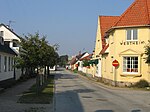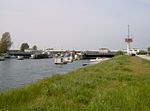Falsterbo Lighthouse
1796 establishments in SwedenBuildings and structures in Skåne CountyLighthouses completed in 1796Lighthouses in SwedenLighthouses in the Øresund Region ... and 3 more
Meteorological stationsScaniaTowers completed in 1796

Falsterbo Lighthouse (Swedish: Falsterbo fyr) . To the north-east of the lighthouse is the city of Skanör-Falsterbo, to the south-east of the lighthouse are some of the finest sandy beaches in Sweden and surrounding the lighthouse is the golf course of the Falsterbo Golf Club.
Excerpt from the Wikipedia article Falsterbo Lighthouse (License: CC BY-SA 3.0, Authors, Images).Falsterbo Lighthouse
Fyrvägen, Vellinge kommun
Geographical coordinates (GPS) Address External links Nearby Places Show on map
Geographical coordinates (GPS)
| Latitude | Longitude |
|---|---|
| N 55.383796 ° | E 12.816399 ° |
Address
Falsterbo fyr
Fyrvägen
239 40 Vellinge kommun, Falsterbo
Sweden
Open on Google Maps







